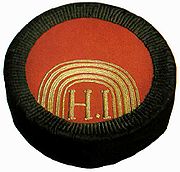
Montenegrin cap
Encyclopedia




Cap
A cap is a form of headgear. Caps have crowns that fit very close to the head and have no brim or only a visor. They are typically designed for warmth and, when including a visor, blocking sunlight from the eyes...
tradition
Tradition
A tradition is a ritual, belief or object passed down within a society, still maintained in the present, with origins in the past. Common examples include holidays or impractical but socially meaningful clothes , but the idea has also been applied to social norms such as greetings...
ally worn by Montenegrins and Serbs of Montenegro
Serbs of Montenegro
Montenegrin Serbs is a regional, ethnographic group of ethnic Serbs. They compose the second largest ethnic group in Montenegro after the Montenegrins....
. Originally worn by males, it is now not exclusively for them.
The cap is originally in the shape of a flat cylinder
Cylinder (geometry)
A cylinder is one of the most basic curvilinear geometric shapes, the surface formed by the points at a fixed distance from a given line segment, the axis of the cylinder. The solid enclosed by this surface and by two planes perpendicular to the axis is also called a cylinder...
, having a red upper surface (called tepelak) not dissimilar to the Herzegovina
Herzegovina
Herzegovina is the southern region of Bosnia and Herzegovina. While there is no official border distinguishing it from the Bosnian region, it is generally accepted that the borders of the region are Croatia to the west, Montenegro to the south, the canton boundaries of the Herzegovina-Neretva...
and Lika cap
Lika cap
The Lika cap , is a traditional cap used together with the folk attire of the Lika region in Croatia. The hat has a round shape with a flat top; the top color is red while the area around the side is black, often with black tassels hanging down the back. Overtime the cap has become an important...
s. Prince-Bishop Petar II Petrović Njegoš wore it with a black
Black
Black is the color of objects that do not emit or reflect light in any part of the visible spectrum; they absorb all such frequencies of light...
rim (called derevija), and the definition given was as a sign of grief of occupied Kosovo
Kosovo
Kosovo is a region in southeastern Europe. Part of the Ottoman Empire for more than five centuries, later the Autonomous Province of Kosovo and Metohija within Serbia...
. The Kosovo myth was very popular in the old Montenegrin state
Kingdom of Montenegro
The Kingdom of Montenegro was a monarchy in southeastern Europe during the tumultuous years on the Balkan Peninsula leading up to and during World War I. Legally it was a constitutional monarchy, but absolutist in practice...
. The enforcement of the cap upon the Montenegrin chieftains by Prince-Bishop Peter II Petrovic-Njegos was a mark of expression of then's dominating Serbian national identity.
The national telling recorded the most often version of the cap as following: the black wrapper was sign of grief for their once great Empire
Serbian Empire
The Serbian Empire was a short-lived medieval empire in the Balkans that emerged from the Serbian Kingdom. Stephen Uroš IV Dušan was crowned Emperor of Serbs and Greeks on 16 April, 1346, a title signifying a successorship to the Eastern Roman Empire...
, the red the bloody defeat at the Battle of Kosovo
Battle of Kosovo
The Battle of Kosovo took place on St. Vitus' Day, June 15, 1389, between the army led by Serbian Prince Lazar Hrebeljanović, and the invading army of the Ottoman Empire under the leadership of Sultan Murad I...
and the five small stripes on the top represent the remaining remains of the once greater Serbian realm, which became increasingly popular amongst the common folk during the reign of Prince Danilo I Petrović-Njegoš. Within the stripes is angled a six star, representing the last free part, Montenegro, shining upon the fallen and conquered.
Prince Danilo in the many variations introduced his initials "ДI" (Danilo the 1st), while his successor Prince Nikola in the second half of the 19th century replaced it with "Н.I", quite often alongside the letter "Ж" signifying "Живио" (Long live!).
During the Communist era in the second half of the 20th century instead of the Serb cross the Communist Red Star
Red star
A red star, five-pointed and filled, is an important ideological and religious symbol which has been used for various purposes, such as: state emblems, flags, monuments, ornaments, and logos.- Symbol of communism :...
was implanted between the golden stripes, although it was not spread amongst the people and never accepted. Several years ago a new version appeared with a large modern (2004) Coat of Arms of Montenegro
Coat of arms of Montenegro
The coat of arms of Montenegro was officially adopted by the law passed in the Parliament on 13 July 2004...
spread across the cap's red top, that is becoming increasingly popular as a sign of the Montenegrin nation's independence and sovereignty. A female version of the cap was introduced, so far worn almost exclusively by men.

